Archaeologists Discover Colossal Pyramid Belonging to Prehistoric Civilization in Romania
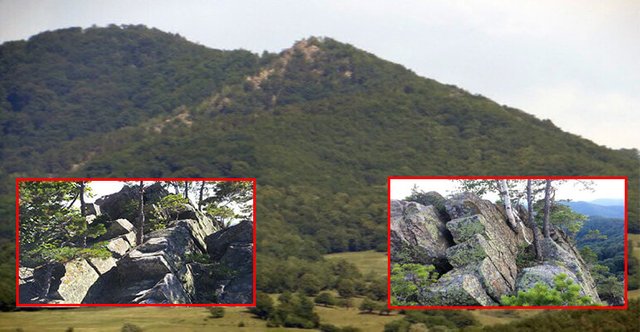
More archaeologists believe to have found a colossal 300-meters-tall pyramid in Romania dating back tens of thousands of years.
Pyramids were a religious trend for ancient civilizations. From Africa to North America, Asia and Europe, these unique structures are spread all across the globe, where various cultures had built them without any apparent connection established between them.
Overall, pyramids share a similar architecture and were envisioned as religious places of extreme importance, be it as a resting place for a great ruler, or a ceremonial center dedicated to the gods.
Although many of these imposing structures have stood the test of time, we only know of those that had been constructed a few hundreds, sometimes thousands of years ago. However, in recent years evidence has been mounting up in regards to antediluvian civilizations which thrived before the last glaciation, or what it has been known as "the great flood". It happened more than 14,000 years ago according to most researchers, and it appears that these timeworn peoples were also skilled pyramid builders.
Could this prove that long before the first known organized societies there were others at least on the same advancement level as today? And were they also able to transit the planet?
Proof of these forgotten forefathers stand both the Sumerian King List and the Egyptian pharaohs timeline which remind of their rulers up to a time when the gods first descended upon the Earth. The nearest palpable evidence of antediluvian civilizations are the Bosnian pyramids discovered in 2005, constructions dating anywhere between 12,500 to 30,000 years back. While investigations at this site are well underway, it appears that another startling discovery has been made a bit due est into the land of Romania.
An intriguing mound from the Buzau mountains chain measuring about 1,000 meters from sea level has captivated the curiosity of archaeologists after they stumbled across the remnants of what they presume to be another ancient megalithic pyramid.

Tuturdui Pyramid covered in luxurious vegetation
As you can see in the above picture, the mountain has all the traits of a pyramid. It measures 300 meters from the bottom, that's 150 meters more than the Pyramid of Giza and 80 meters more than the Pyramid of the Sun in Bosnia.
Archaeologists climbing the top of the alleged monument have found remnants of ancient megalithic walls consisting of three layers of overlaid stones glued together using clay, a material which provides extensive protection from pluvial waters and it's also an excellent choice when binding stones.
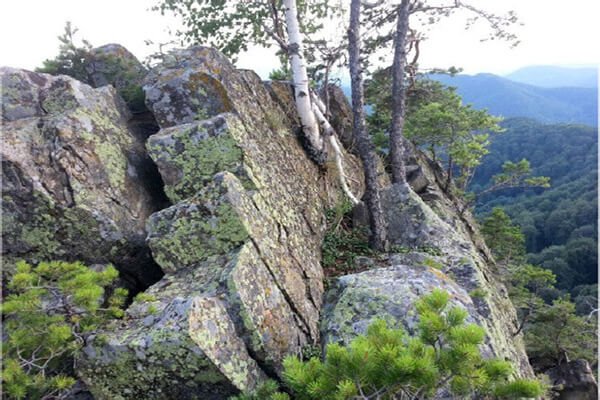
Probably the most intriguing aspect of the fortification was the thick reddish-brown layer of material composed of mineral oxides which covered the exterior wall of the pyramid. Based on this plaster covering even the cracks between stones, researchers were able to date the structure using a technique known as radiestezia, which yielded gripping results – the stones appeared to be 22 to 25,000 years of age.
"I was expecting the results to be around 12,000 years, considering that some of the Sumerian tablets unearthed on our territory mention about King Luana, an antediluvian semi-god that ruled over this land, said Dan Popovici, one of the researchers. "I was astonished when the radiestezic pendant indicated 25,000 years! Although I cannot be 100% sure of this dating, my intuition says this is the right date in time."
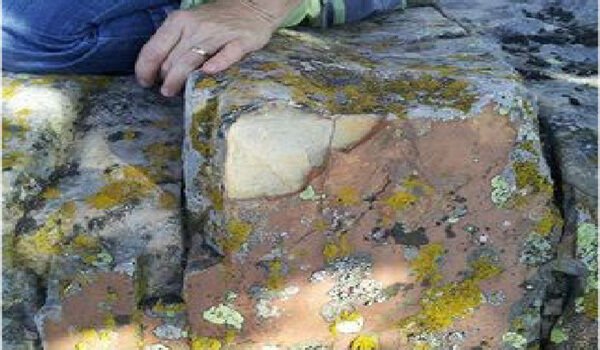
Material used to date the megalithic structure
On several places on the side of the mountain, archaeologists stumbled across more brickwork belonging to this forgotten civilization. The stones seem to be artificially cut and the straight lines further indicate the possible use of advanced technology, while the inclined design of the wall hints at its former triangular shape. Could this have been indeed a stepped pyramid?
According to several sources, the communist regime that had once subdued Romania specialized in concealing and destroying all traces of the heritage left behind by the ancient Romanian people. According to several authors, in 1980 the secret services operating under the communist regime had searched out the summit of this mountain where they had discovered an altar standing on a flat plateau scarred only by the passing of time.
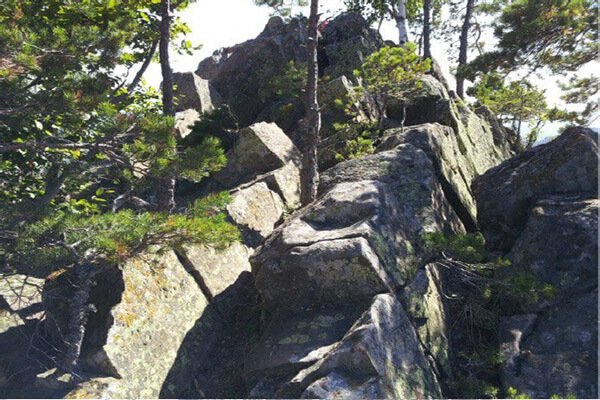
Image with what used to be the terrace of the pyramid
Two agents allegedly breached through an opening of a portal and were never to be heard again. After collecting all the desired material from atop the pyramid, the communists blew up the altar together with the terrace. The story should be taken with a grain of salt, although evidence of the explosion can be seen upon reaching the peak, while other local accounts vividly remind of this incident from the 80s.
Whatever they had found up there we can only guess, but there's no denial the Buzau Mountains of Romania are full of reminders of a complex past, such as underground dwellings, cave carvings and petroglyphs in a language believed to predate the Sumerian dialect.
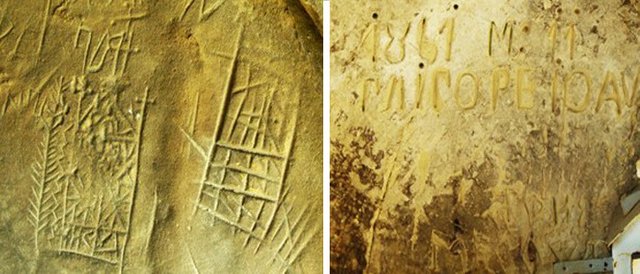
Pre-Sumerian writings found in the area close to the pyramid / on the right side Slavic writings
It's no wonder that such influences existed in this part of the world. North-Eastern Europe is also called the Old Europe, entitled this way to depict a pre-Indo-European culture from the Neolithic (around 7,000 BC) with a strong cultural background. It is thought they would exchange knowledge with the ancient Greeks. Unquestionable proof of this stands the clay tablets unearthed at Tartaria, Transylvania, which bear inscriptions belonging to the Vinca, a culture with a writing system predating that of the Sumerians.
They were also able to reach all the way to Mesopotamia through a landmass substituting what is now the Black Sea. Thousand of years ago this body of salt water was comprised of a series of freshwater lakes. Circa 5,600 B.C. It formed into the Black Sea after the waters of the Mediterranean breached a sill through the Bosphorus strait, but once again this is just a hypothesis.
With so many ancient riddles that are only now being brought to light, it's no surprise if after a few more years of archaeological breakthroughs we'll have to rethink the entire history of humanity. The lack of technological means, or better said the limited access to LIDAR technology pushes hard on the shoulders of any archaeologists who wants to prove that our defined timeline has numerous flaws and requires a serious revision.
However, the years to come promise to dramatically lower the costs of underground scanning equipment and so every aspiring archaeologist may become a professional. Looking forward into the future!
Photo credits: Dan Popovici

It was a pleasure to read this article again ! Congratulations
@minnowpond1 has voted on behalf of @minnowpond. If you would like to recieve upvotes from minnowponds team on all your posts, simply FOLLOW @minnowpond.
Great article! Thanks for sharing, I'm from Romania and I like&know about this topic. Nice one!